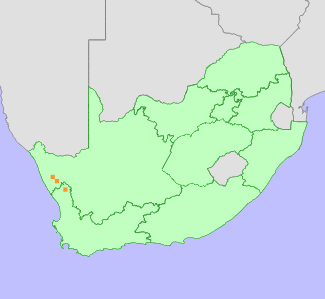|
Scientific Name | Hesperantha decipiens Goldblatt |
Higher Classification | Monocotyledons |
Family | IRIDACEAE |
National Status |
Status and Criteria | Rare |
Assessment Date | 2021/05/26 |
Assessor(s) | P.A. Manyama, D.A. Kamundi & T. Patel |
Justification | This restricted range species has an extent of occurrence (EOO) of 315 km². It is a habitat specialist with an area of occupancy (AOO) of 16 km², and is known from four subpopulations. There are no known threats to this species. Globally, it is listed as Least Concern, and nationally, as Rare. |
Distribution |
Endemism | South African endemic |
Provincial distribution | Northern Cape, Western Cape |
Range | It is endemic to South Africa, and extends from near Springbok in Northern Cape through the Kamiesberg to the northern Knersvlakte in Western Cape. |
Habitat and Ecology |
Major system | Terrestrial |
Major habitats | Fynbos, Succulent Karoo |
Description | It occurs on thin, sandy gravel, often on granite pavement. |
Threats |
| There are no known threats to this species. |
Population |
This species is rare and local within its habitat. The population size is currently unknown but the trend is suspected to be stable.
|
Population trend | Stable |
Assessment History |
Taxon assessed |
Status and Criteria |
Citation/Red List version | | Hesperantha decipiens Goldblatt | Least Concern | Raimondo et al. (2009) | |
Bibliography |
Goldblatt, P. and Manning, J.C. 2020. Iridaceae of southern Africa. Strelitzia 42. South African National Biodiversity Institute, Pretoria.
Raimondo, D., von Staden, L., Foden, W., Victor, J.E., Helme, N.A., Turner, R.C., Kamundi, D.A. and Manyama, P.A. 2009. Red List of South African Plants. Strelitzia 25. South African National Biodiversity Institute, Pretoria.
|
Citation |
| Manyama, P.A., Kamundi, D.A. & Patel, T. 2021. Hesperantha decipiens Goldblatt. National Assessment: Red List of South African Plants version 2024.1. Accessed on 2025/10/26 |
 Comment on this assessment
Comment on this assessment


